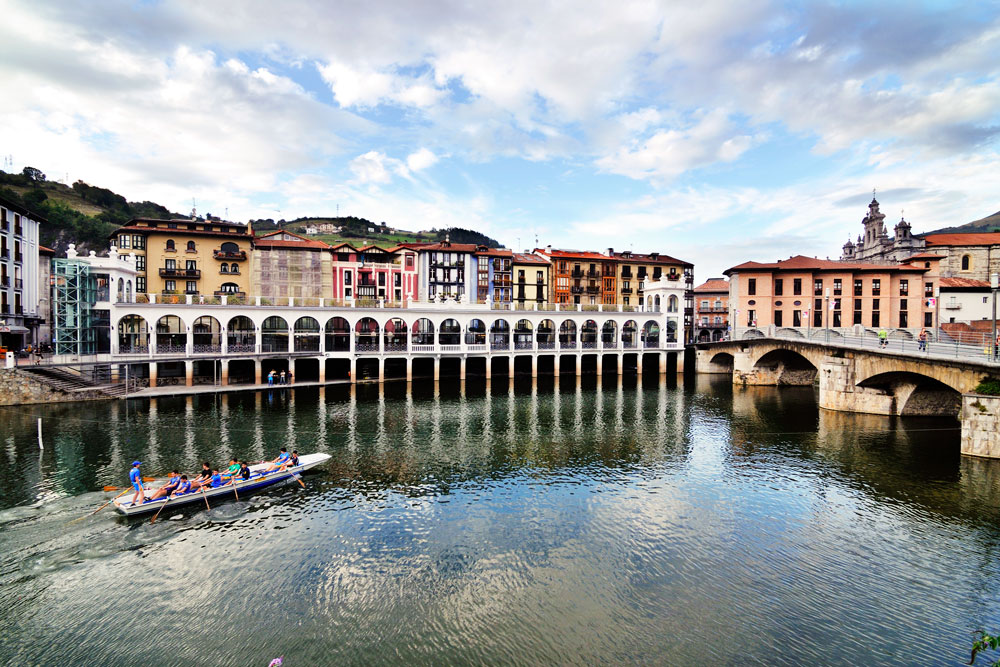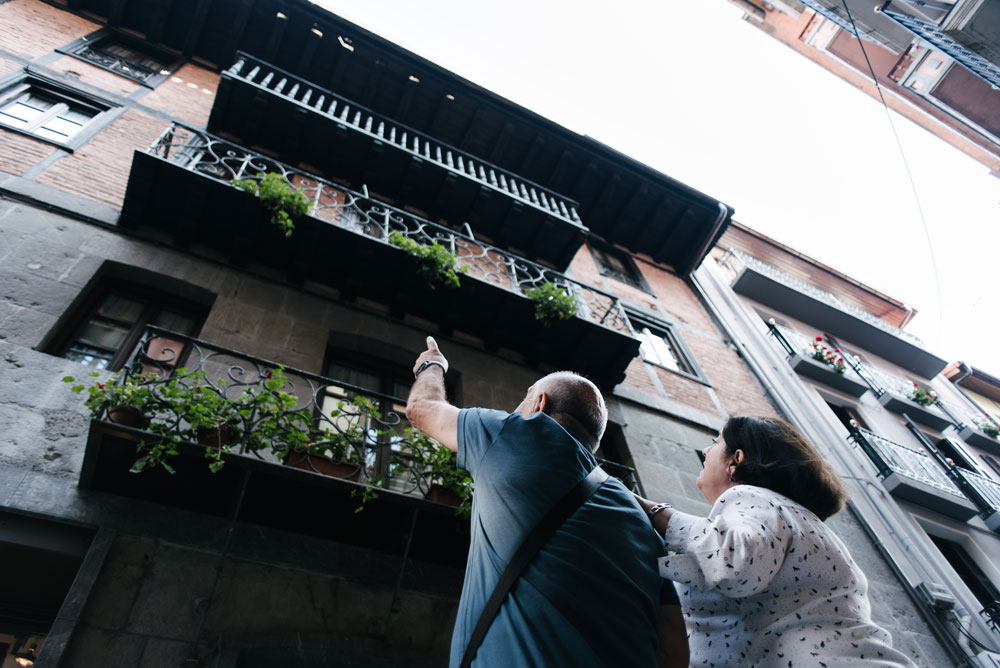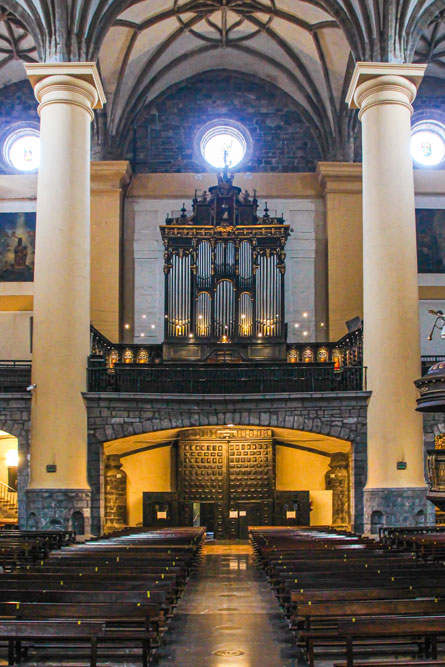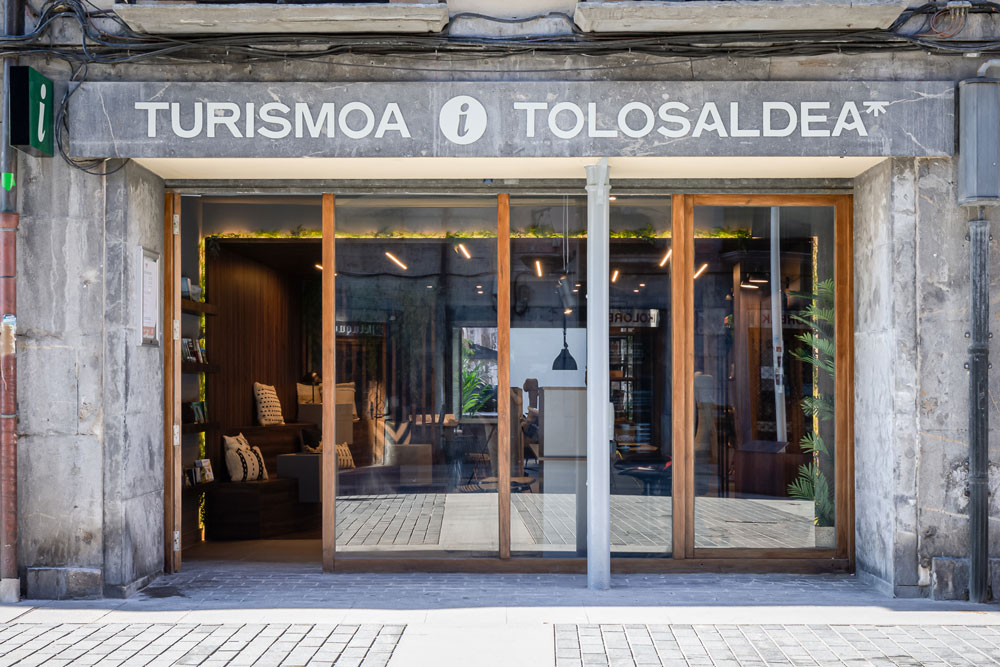The great history that hides the Old Town of Tolosa
A tour through the most interesting of Tolosa
The monumental heritage of Tolosa
We propose you all a tour to know the most emblematic points of the old quarter of Tolosa, and thus know the history and evolution of the town. To know more and understand how and why Tolosa is like this, we recommend you to take the guided tour.
Arch of Castile
It is one of the last vestiges of medieval Tolosa. In the Middle Ages, Tolosa was an island surrounded by the Oria River and the hidden Erretengibel channel. The island was walled and had five accesses, where the passage and goods were controlled. This was one of the most important doors. Tolosa had a strategic location, being a place of passage on the way to France, Castile and Navarre.
Tinglado
It has hosted the market since 1785, although the market has been held in Tolosa since the thirteenth century. It is located between the two most important roads of the eighteenth century: the Camino Real de Castilla, and the one that led to Navarre through the bridge that crosses the river. The market was a must stop for bartering. Currently, the market of local fresh products is held every Saturday.
Navarre Bridge
It is part of the emblematic view of Tolosa. It has always guaranteed the passage to Navarre. It is believed that it was already made of stone in the thirteenth century. It originally had three spans, a fourth being added in the eighteenth century. It has two solid masonry sterlings in the center of the riverbed, and a smaller one towards the left bank. The arches are different from each other and are built in gray limestone.
Convent of Santa Clara
This eighteenth-century church is attached to the monastery of the Poor Clares. It is a baroque temple of beautiful proportions and latin cross plan. It was used as a military hospital, after being occupied by French troops in the Convention War, the War of Independence and the Carlist Wars.
Idiakez Palace
It is a baroque style building (seventeenth century), and is located on one of the oldest plots of the town. The main façade is made of masonry, and the side of brick. In 1794 lived in the palace the former mayor of Tolosa and writer of fables Felix M. de Samaniego y Zabala. Later, the building becomes a Casino. And, today, it is a gastronomic society designed by Néstor Basterretxea: Casino de Tolosa.
Town hall
Built in the seventeenth century in Baroque style, it has the porticoed ground floor and wrought iron balconies. It was built by the master stonemason Juan de Arburola. It is linked via a small bridge to the adjoining palace, the Aburuza Palace. The Old Square where they are located, center of all the popular festivals, was built taking advantage of 5 plots that were razed in the fire of 1503.
Parish of Santa Maria
With 1,630m2 of surface, it is the second largest church in Gipuzkoa. It took more than 200 years to build. It combines the style called Basque Gothic, with Renaissance, Baroque and Neoclassical. The set of pillars is formed by three naves of the same height, which have a enervated vault each. It is possible to visit the vaults of the church, whose wooden structure is original.
Aramburu Palace
Building of the seventeenth century, example of the Basque Baroque. Its façade is simple, built in paddy masonry, following the principles of symmetry and centrality of classicism. The coat of arms is of the legislator Miguel de Aramburu, who wrote the compendium of the fueros of Gipuzkoa in 1697. Nowadays the Library and the Municipal Archive are located there.
Mill
It was built in the fourteenth century after Tolosa was granted the royal privilege to enable it within the walls. It belonged to the town hall until the late nineteenth century. The company Boinas Elósegi (Berets) exploited it to obtain energy for a century, until in the 70s, when its activity ceased, the mill returned to belong to the municipality of Tolosa. After its rehabilitation, today it is the children’s library.
Archaeological Park
Tolosa, grew around a historic center where the archaeological park formed by the medieval necropolis, the wall that defended the old town, the hydraulic infrastructure of a mill dating back to 1332 and the remains of a large Renaissance palace that Alonso de Idiakez had built in 1530.
Lapaza House
It is one of the most important examples of Basque architecture. House of four floors, the first two built with ashlar walls, and the rest with bricks of the municipal factory. Half-timbered and carved wooden eaves.
Iturritza Palace
Built in the late sixteenth century on a medieval site. It has three floors; the one below is made of masonry and has double angular corners. It was rehabilitated and the façade was unplastered, leaving exposed the brick manufactured in the municipal bricks of Tolosa. On both sides of the balcony, the same coat of arms appears, the ones of Miguel de Mendiola and his wife Magdalena de Unanue. From 1612 to 1666, the community of poor clare nuns stayed in this palace.
Verdura Square
Urban space of singular interest, built in 1899, by the architect José Alejandro Múgica. It occupies the place that since the Middle Ages had a corn exchange and market functions. It combines the use of iron and a glazed roof, surrounded by the arches of the square. Here takes place every Saturday the vegetables, plants and flowers market.
Andia Tower
It is the most significant manor house, but only the coat of arms and two gargoyles (fifteenth century) remains on the façade. It is said that the first building in Tolosa was built here. For many years it was the boardroom of the town hall and place of residence of Domenjon González de Andia (falsely considered King of Gipuzkoa).
Palace of Atodo
It is of Renaissance style; the façade is made of ashlar masonry, and is protected by a double carved eaves. It has an artistic coat of arms. It was the birthplace of Fermín de Atodo: Count Palatine, captain of the Army´s Thirds of Tolosa, and ambassador of Philip II in Rome, in 1558. The hole in the façade corresponds to what was the Royal Mailbox, where the letters for the king were deposited.
New Square
Last square that was formed in the Historic Center in the early eighteenth century, in the place called Iribaratzeta, where the orchards were once located. In it was located the second town hall, today is called Abastos by locals. It also housed the market. In this square all kinds of celebrations and parties were celebrated, including bullfighting celebrations. The paintings of the music kiosk are the work of the Tolosa´s painter Iñaki Epelde.
Euskal Herria Square
Neoclassical arcaded square of the nineteenth century, which stands out for its spaciousness and symmetry: each of its sides measures 50 meters. The main palace is the former Courthouse, is noted for the many materials used in its construction and because it only has two floors (the surrounding buildings have three). In the prison of this court, the singer-songwriter Jose Maria Iparragirre composed a well-known song dedicated to his mother: Nere amak baleki (If my mother knew…).
Palace of the Provincial Council
Building built following the line of the old wall, perpendicular to the streets of the old town. It is of Elizabethan neoclassical style, although in the 80s they reformed it completely, to build a multipurpose culture house. Between 1844 and 1854 it was the Government of the Provincial Council of Gipuzkoa, when Tolosa was the capital of Gipuzkoa. The sculpture that emerges in the middle of the Triangle square is Atauts, a steel work made by the sculptor Jorge Oteiza.
Church of San Francisco
It is a church built in the sixteenth century, Renaissance style. It has a simple façade and a single nave, with a barrel vault. In the dome has paintings by Pablo Uranga, and a great Renaissance altarpiece, finished in 1615 by Ambrosio de Bengoetxea. During the Carlist Wars it was a barracks, hospital and warehouse. In what were once its orchards today we see the Beotibar Fronton and the General Archive of Gipuzkoa.





























